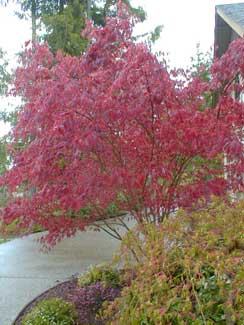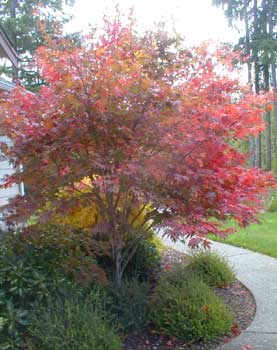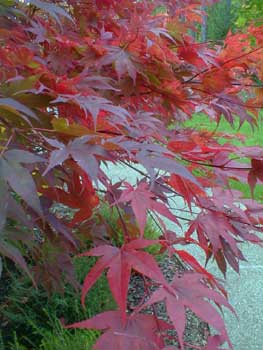
'Bloodgood'
Red Japanese Maple
"Mist goes up from the rain steeped earth, & clings
Ghostly with lamplight among drenched maple trees.
We walk in silence & see how the lamplight flings
Fans of shadow upon it the music's mournful pleas
Die out behind us, the door is closed at last,
A net of silver silence is softly cast."
-from Nocturne of Remembered Spring
by Conrad Aiken
(1889-1973)
by Conrad Aiken
(1889-1973)
Acer palmatum atropurpureum 'Bloodgood' is probably the single most popular upright purple-leafed Japanese maple. To the connoisseur, 'Bloodgood' may seem too awfully commonplace, & for braggart rights it can be great fun to have a variety much more obscure than this. But 'Bloodgood' is popular with cause, invariably easy to grow & beautiful for color & form.
 The leaf-form is standard palmate, wine-red or burgundy in spring, holding its color in summer fairly well, especially in dappled shade. In fuller sun it may turn partially bronzed-green before summer's end, but without much chance of experiencing leaf-scorch. The leaves usually become vibrantly scarlet in Fall, although this can vary from year to year & sometimes the autumn color is very close to its original shade of wine-red it first showed in spring.
The leaf-form is standard palmate, wine-red or burgundy in spring, holding its color in summer fairly well, especially in dappled shade. In fuller sun it may turn partially bronzed-green before summer's end, but without much chance of experiencing leaf-scorch. The leaves usually become vibrantly scarlet in Fall, although this can vary from year to year & sometimes the autumn color is very close to its original shade of wine-red it first showed in spring.The samaras or winged seeds appear in April & ripen to red in summer. They cling to the branches until winter or spring when they turn brown. Seedlings are apt to erupt around the parent tree & should probably be transplanted to pots & babied in coldframes for a couple of years.
'Bloodgood' however is properly a grafted tree, even if often enough seed-grown specimens will be given the parent's name. Completely honest growers will offer the seed-grown specimens not as 'Bloodgood' but only as palmate 'Atropurpureum.' They will in either case in all likelihood be fine trees, but the intensity of color is unpredictable when seed-grown.
 'Bloodgood' is a vigorous upright tree that reaches fifteen feet in ten years, more or less, & could eventually be a twenty-five foot tree or taller, capable of developing a leaf-crown almost as wide as it is high.
'Bloodgood' is a vigorous upright tree that reaches fifteen feet in ten years, more or less, & could eventually be a twenty-five foot tree or taller, capable of developing a leaf-crown almost as wide as it is high.Although it is one of the larger A. palmatum cultivars, it is nevertheless a small tree that can look proportional for smaller yards. Its growth rate is moderately swift when young but at around seven or ten feet it slows down considerably.
Trunks & main limbs of mature specimens are grey, but younger branches & twigs are red-black. It is commonly though not invariably multi-trunked, depending on its youthful training. It's occasionally grown as a multi-stemmed shrub which will never get as tall.
Very hardy for zones 6 through 8, it is stretchable to zones 5 through 9 with protection at the extremes. It's adaptability is the reason it has become one of the most common atropurpureums encountered not only in Northwest gardenscapes, but in Southern landscapes too, where most Japanese maples would be stressed & rapidly decline.
The origin of 'Bloodgood' is somewhat shadowed by time, as it is one of the oldest forms grown in the United States. It is named for the Bloodgood Nursery founded in 1793 on Long Island, which was the first American vendor of this variety, introduced to North American gardening shortly after the Civil War, a very long time before the general craze for Japanese maples was really begun & the tree was practically unknown in North America.
Where Bloodgood Nursery obtained their first specimens, at a time when Japan itself was still closed to the west, is not well documented. European growers claim it as theirs, & it may have been first grown without a name in The Netherlands as a select form of the first 'Atropureums' obtained from Japan through the sole trading port in Nagasaki.
However, 'Bloodgood' is actually quite a varied tree & almost certainly embraces more than one strain selected from among 'Atropurpureum' over a century ago, & even some 20th Century look-alikes & selected strains have gotten the name 'Bloodgood' attached to them due to the popularity of trees baring this name.
The first photo at top shows 'Bloodgood' in April with the leaves a tad shy of fully reaching their full size. The second photo shows it from the opposite side of the paved entry, not quite at its reddest, & behind it can be seen the bright yellow autumn colors of another Japanese maple, a weeping green laceleaf 'Viridis.' The third photo shows the leaves a bit redder later in October. See additional the 'Bloodgood' Page of the Autumn Trees Gallery.